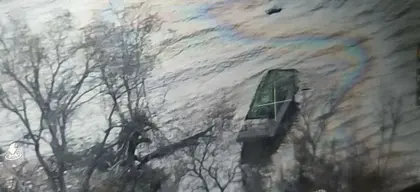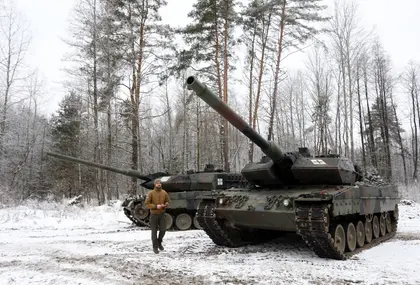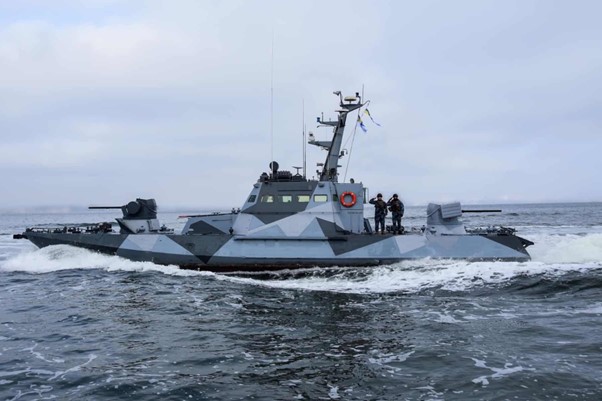An incrementally growing Ukrainian bridgehead on the east bank of the Dnipro River has for the first time been reinforced by armored vehicles, Russian information platforms focused on the war and news platforms reported on Wednesday.
Drone images of a single Ukrainian BTR-4 armored personnel carrier being ferried across the river aboard a Soviet-era amphibious transport were reportedly captured on Monday or Tuesday near the east bank village of Krynky, an outpost captured by Ukrainian Marines in late October.
JOIN US ON TELEGRAM
Follow our coverage of the war on the @Kyivpost_official.
Kyiv special operations and reconnaissance troops had operated in the waterways and marshes of the lower Dnipro River since at least May.
The first Ukrainian moves to land combat infantry with the mission to hold ground on the opposite, Russia-held side of the river were launched around Oct. 15.
A second Marine crossing took place some 25 kilometers (15.5 miles) upstream on Oct. 25-27.
Ukrainian Marines and support troops are now reportedly digging in at least four sites along the river’s east bank (or “left bank” due to the river flowing south) along a stretch of territory 30-35 kilometers (19-22 miles) long.
The enclaves are not connected but Kyiv forces are improving and slowly expanding their positions, at times under Russian artillery fire and intermittent Russian air strikes, Russian military commentators have said.
Roman Kulikovsky, author of the pro-Russia Starshe Eddy Telegram news channel, said Kyiv’s transfer of armored vehicles to the growing bridgehead around Krynky would complicate Kremlin efforts to eliminate it.

Ukraine’s Navy Shoots Down Russian Missile – A New Air Defense Strategy?
Currently, he said, Ukrainian Marines hold outposts and observation posts in the villages Krynky, Kusaseve, Peschanivka, and on the northern section of Aleshkin Island.
Ukrainian Marines most recently have begun operating patrols and setting up ambushes along the road connecting the villages of Postepne and Kazachy Lager, Kulikovsky said.
The Ukrainian military has slapped down a near-total ban on information about cross-river operations, confirming only that Marines are among the troops defending outposts on the east bank of the Dnipro River.
The Russian reports identify the Ukrainian parent formations with infantry detachments across the river as the 35th, 36th, 37th and 38th Marine Brigades and the 140th Separate Reconnaissance Battalion. Social media linked to the 35th and 36th confirm troop presence on the east bank.
According to most Russian and Ukrainian independent commentator reports, the Ukrainian toeholds, prior to reinforcement by BTR-4 fighting vehicles, were of limited strength – with a platoon to a company of Marine infantry (25-150 men) at each location.
The strongest Ukrainian positions are in the villages of Postepne and Peschanivka, most reports say.
Reports were not clear how many BTRs crossed the river.
The BTR-4 Butsefal (Ukrainian: Bucephalus) is a Ukraine-manufactured 4X4 eight-wheeled fighting vehicle with a combat weight of up to 25 tons.
Most commonly armed with an automatic cannon and anti-tank missiles, the system is standard equipment in the Ukrainian Marines and was first used in combat in 2016, during Russia’s first invasion of Ukraine.
Although not designed to stand up to a tank, in the Armed Forces of Ukraine (AFU) BTR-4 is generally considered reliable and effective, particularly in defending a fortified position. Troops consider it spacious and often praise its joystick-operated targeting system.
Throughout the Dnipro River bridgehead terrain is mostly wet, marshy and thickly wooded.
By conventional tactics as practiced by both the Russian and Ukrainian militaries, the most likely use of a light armored vehicle like a BTR-4 would be to block one of the few hard roads in the vicinity or to attack an encroaching foot patrol.
Although the BTR-4 is amphibious, per recent images, Ukrainian planners transferred the fighting vehicles to the east bank aboard a Soviet-era PTS-2, a tracked amphibious carrier designed to haul a single military fighting vehicle across water too deep to cross by driving.
In July, Ukraine’s military published images of a Marine unit training to cross a water obstacle aboard PTS transports operated by the 48th Engineer Brigade, a unit specializing in constructing fortifications and military barriers, and assaulting them.
Official Russian army statements have, since late October, acknowledged Kyiv forces operate on the east bank of the Dnipro – but have characterized them as weak in strength and mostly destroyed quickly by Russian artillery and air strikes.
On Oct. 30 the Kremlin sacked the general commanding all Russian forces in the southern sector, according to news reports, because he and his staff concealed from their Moscow bosses the scale and intent of the Ukrainian river crossing operation.
The Ukrainian military’s seemingly continuing unopposed transfer of force to the left bank, now including armored vehicles, on Tuesday, drew almost immediate fire from pro-Moscow military bloggers saying Moscow was still responding to a worsening tactical situation on the Dnipro Riverfront by, for the most part, pretending it doesn’t exist.
Mikhail Zvinchuk, author of the pro-Kremlin RybarZ Telegram channel, in a Tuesday article said Ukrainian troop strength around Krynky alone has already expanded to more than 300 soldiers, and that Kyiv has not stopped reinforcing its positions on the Dnipro left bank with troops and equipment, at multiple crossing sites.
Russian army leadership in the sector has been effectively inert and Russian troops facing the Ukrainian Marines are unlikely to be able to deal with the lodgment in the face of Ukrainian drone swarms, jamming and powerful Ukrainian artillery firing, in support of the Marines from the Dnipro’s right bank, he said.
“The enemy (Ukrainian Marines) is able to act so brazenly due to relying solely on a huge number of FPV (First Person View) drones and an electronic warfare system, UAV centers, and electronic warfare stations that are located on the islands. Without disabling these nodes, the courage of the (Russian) infantry alone cannot resolve the situation,” Zvinchuk wrote.
“We (Russian military bloggers) have been writing for a month now that the enemy is building a bridgehead and is taking daily actions to expand the controlled territory on the left bank. We have been writing since the summer that the enemy is preparing pontoon-bridge crossings and floating transporters, as well as conducting exercises to overcome large water obstacles in conditions of fire resistance,” Zvichnuk said.
You can also highlight the text and press Ctrl + Enter













